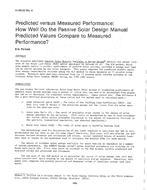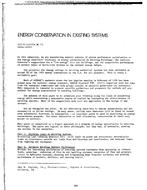Click here to purchase
This paper presents an analysis of occupancy and occupancy-related data gathered from an academic office building. The data set contains records from the WiFi access points, motion detectors, CO2 sensors, light power and plug-load meters, and camera-based image processing sensors. Concurrent ground-truth occupant counts were collected on five days. Two sensor fusion model formalisms were developed to blend the information in individual data streams: multiple linear regression and artificial neural networks (ANNs). The results indicate that low-cost data streams that are not intended for occupancy sensing, such as WiFi traffic, CO2 concentration, and light power and plug-load data, perform at least as accurately as motion detectors and camera-based image processing sensors in estimating the total number of building occupants.
Citation: 2019 Annual Conference, Kansas City, MO, Technical Papers
Product Details
- Published:
- 2019
- Number of Pages:
- 18
- Units of Measure:
- Dual
- File Size:
- 1 file , 4.6 MB
- Product Code(s):
- D-KC-19-006


